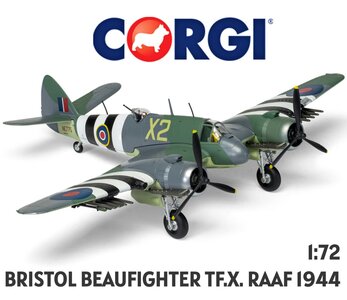MODEL AIRPLANES / SCALE 1:72 / CORGI | BRISTOL BEAUFIGHTER TF.X. NE775/X2 455 SQN RAAF JUNE 1944 LIM.ED. | 1:72
Bristol Beaufighter TF.X NE775/X2 455 Sqn RAAF June 1944
| FABRIKANT | SCHAAL | |
| CORGI | 1:72 | |
| Type vliegtuig | Maritiem aanvalsvliegtuig | |
| Periode | 1944 D-Day Operation Overlord | |
| Krijgsmacht | RAAF (Royal Australian Air Force) | |
| Afmetingen | Lengte 17.5 cm Spanwijdte 24.6 cm | |
| Materiaal | Die-cast metaal model met kunststof onderdelen | |
| Conflict | Tweede Wereldoorlog / WWII | |
| Gelimiteerd |
Ja genummerd certificaat tot 1000 stuks
|
|
| Bijzonderheden | Met D-Day strepen op vleugels / landingsgestel in of uit / incl. figuren en standaard |
The Bristol Type 156 Beaufighter (often called the Beau) is a British multi-purpose aircraft developed during World War II by the Bristol Aeroplane Company. It was originally designed as a heavy fighter variant of the Bristol Beaufort torpedo bomber.
No. 455 Squadron Royal Australian Air Force began operations in the ETO as part of RAF Bomber Command, but was transferred to Coastal Command in late April 1942. While still flying the Handley Page Hampden, the crews had to train immediately in delivering aerial torpedo attacks in anticipation of flying anti-ship operations against Axis ships operating in Norwegian coastal waters.
Flying from their home base at Leuchars in Fife, their Hampdens were not particularly suited to this type of mission and initial success rates were disappointing, with many crews paying the ultimate price for their aircraft's lack of capabilities. Things improved from December 1943 when the unit traded in their Hampdens for Beaufighters and crews immediately developed tactics to maximise the impact of their capable new aircraft.
Operating together with No.489 Squadron (RNZAF), the two formed the 'ANZAC Strike Wing', using the combined strength of both squadrons to launch devastating attacks on Axis shipping in the North Sea. Beaufighters configured as heavy fighters attacked enemy anti-aircraft defences and neutralised them before the bomb- and torpedo-equipped aircraft struck their devastating blow.
The Strike Wing's tactics proved so effective that they were later called upon to clear the sea lanes of the English Channel in the months leading up to D-Day, with special attention paid to the E-boats that posed such a threat to Allied invasion planning.

Do you have a question about this product?
Ask us your question
Ask a question about this product

Your question has been sent! Thank you.
We will provide you with an answer as soon as possible.










